This article will show you how to export projects to PDF, Word, and Excel. Then, you can use these exporting methods to save projects as document types. Let’s open ActivePresenter 8 and get started now!

On the whole, to export to any type of document format, let’s access the Export tab and select one. As a result, this opens corresponding dialogs in which you can define many options for exporting.
Export Projects to PDF Document
Basically, when exporting a project to a PDF document, ActivePresenter will export slides as images and embed them into PDF files afterward. For this reason, you cannot edit slide objects anymore.
You can define many options for exporting from the Export To PDF Document dialog. It has two tabs and we’ll get to know each of them in detail:
General Tab
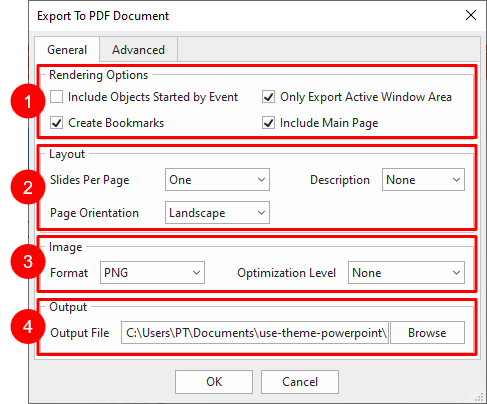
Firstly, we’ll walk through four main sections:
Rendering Options
When creating projects, especially creating eLearning courses or software simulations, ActivePresenter allows you to choose which properties of the project to render in the output. To do that, just select the check box next to each option.
- Include Objects Started by Event: The output PDF file will include objects which are started by events and actions.
- Create Bookmarks: ActivePresenter creates bookmarks from slide names and each bookmark links to a corresponding slide image in the PDF format. The first bookmark level is the slide group title while the second one is the slide name. In other words, ActivePresenter will create bookmarks that link to each page of the PDF file.
- Only Export Active Window Area: The exported area only includes the active window area and slide objects which are selected to export.
- Include Main Page: The exported file will include a page that has a brief description of a project such as a project name and author.
Layout
Overall, this section lets you specify the page orientation, as well as the number of slides on each PDF page.
- Slides Per Page: Decide the number of slides per PDF page.
- One: Export a single slide per page.
- Two: Export two slides per page.
- Contiguous: The slides are written contiguously on a page until there is not enough space, then it will be moved to the next page.
- Page Orientation: Choose from landscape and portrait. The page size is always A4. ActivePresenter uses fixed margins of 1” (2.54 cm) on all sides.
- Description: Export slide description and specify which side of the slide to place it (Top, Left, Right, or Bottom). On the other hand, selecting None to disable this option.
Image
As can be seen, the Image section lets you define the quality of the document background.
- Format: Select from JPEG (lossy compression) and PNG (lossless compression). Due to their specs and compression algorithms, JPEG is best suitable for pictures while PNG is best suitable for computer graphics (screenshots, drawings, etc.).
- Optimization Level: Applicable to the PNG format only. This option specifies a relative compression level (none, low, normal, high, ultra). In general, the higher the compression level, the smaller the output file size, and the longer it takes to export.
- Quality: Applicable to the JPEG format only. Specify image quality in the range of 1% to 100%. The higher the quality, the larger the output file size.
Output
- Output File: Specify the file path and name for the PDF document.
Advanced Tab
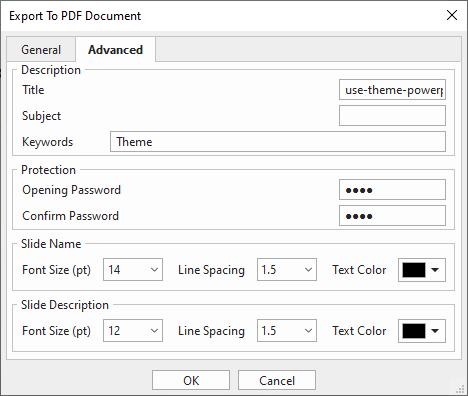
To begin with, let’s explore 4 sections in the Advanced tab respectively:
Description
As can be seen, the Description contains PDF document-related options.
- Title: Title of the PDF document (e.g. using_theme_powerpoint.pdf). When you open the PDF in a viewer, the title appears in the windows bar (or in the tab in the case of a tabbed PDF reader).
- Subject: Subject of the PDF document. This is one of the PDF document properties that users can see in Document Properties in any PDF viewer.
- Keywords: Keywords defined in the PDF document.
Protection
In general, this section contains a security password for opening the PDF document.
- Opening password: You can set a password for opening this PDF document.
- Confirm password: Enter the password again manually (no copy-paste from the previous field).
Slide Name
Specify the appearance of the slide name in the PDF document. By default, the font size is 14, the line spacing is 1.5, and the text color is black. However, you can change the value and color if you want.
Slide Description
Define the look of the slide description in the PDF output. By default, the font size is 12, the line spacing is 1.5, and the text color is black. However, you can customize these values if you want.
Now, take a look at the below example. It is the screenshot of the PDF file output of the software simulation project. As can be seen, the output file has one slide per page with the landscape page orientation, etc.
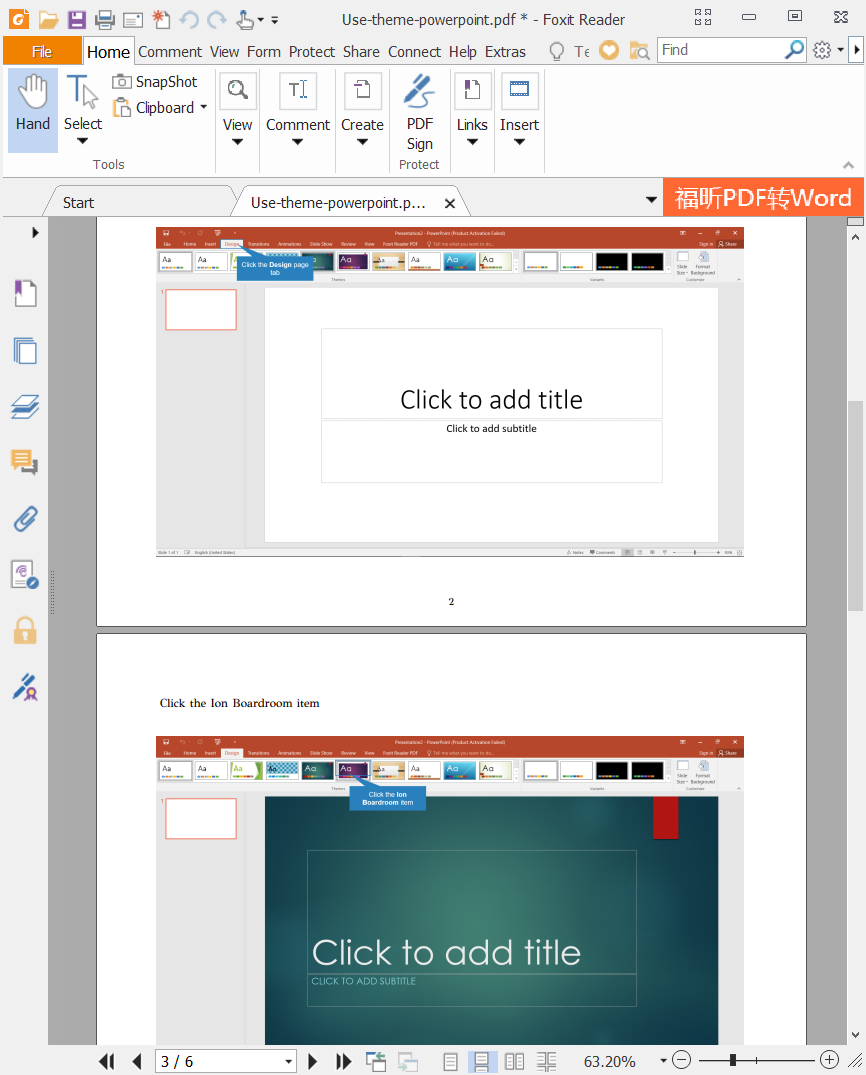
Export Projects to Microsoft Word
Overall, the Export To Microsoft Word dialog has the General tab only. This tab has many properties which are in common with those of the Export To PDF Document dialog. So, see the General tab section above to know more.
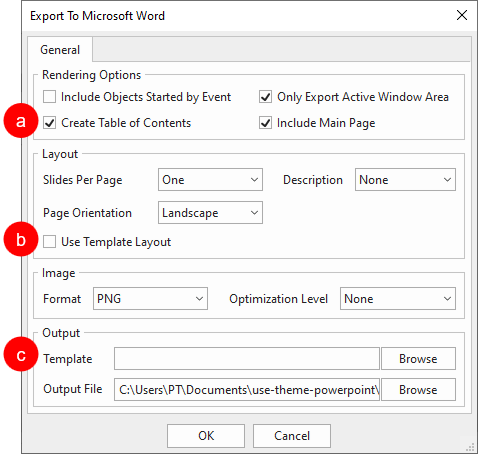
In addition, there are some further options when exporting to Microsoft Word.
- Create Table of Contents (a): Add a table of contents to the exported document with hyperlinks to slides.
- Use Template Layout (b): Use the layout specified in the Word template.
- Template (c): Specify the location of the template file. In case you want the exported file to have a particular template, choose one from existing Word templates.
Export Projects to Microsoft Excel
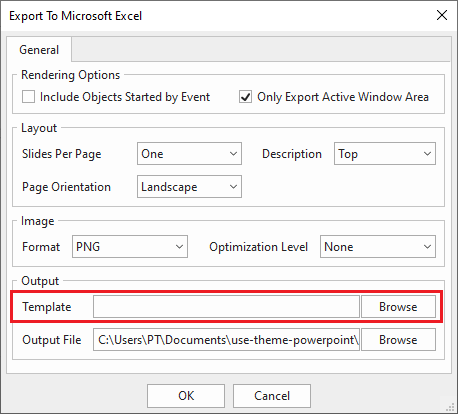
When it comes to exporting projects to Excel documents, you will have the Export To Microsoft Excel dialog which also has the General tab only. Basically, this tab is similar to the General tab in the Export To PDF Document dialog mentioned above. However, there is one different option:
- Template: Specify the location of the template file. If you want the exported file to have a particular template, choose one from existing Excel templates.
Note: When exporting to Microsoft Word or Microsoft Excel, slides will be converted into text, images, as well as objects and inserted into a Word or Excel file afterward. As a result, those objects are editable.
So, you know how to export projects to PDF, Microsoft Word, Microsoft Excel in ActivePresenter 8. Visit our Twitter, Tutorial page, and YouTube channel to get more useful information when using ActivePresenter features.
Recommended articles: